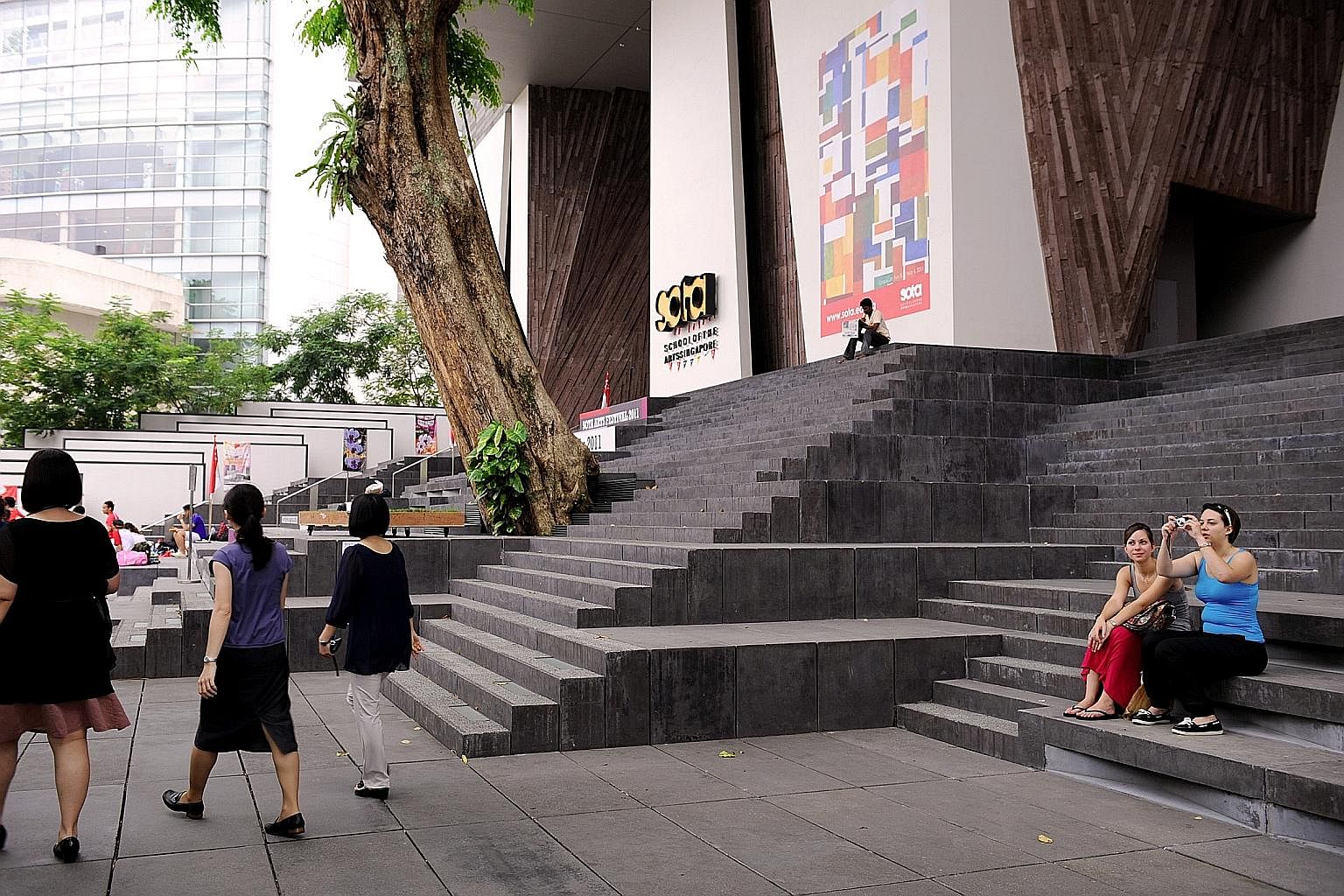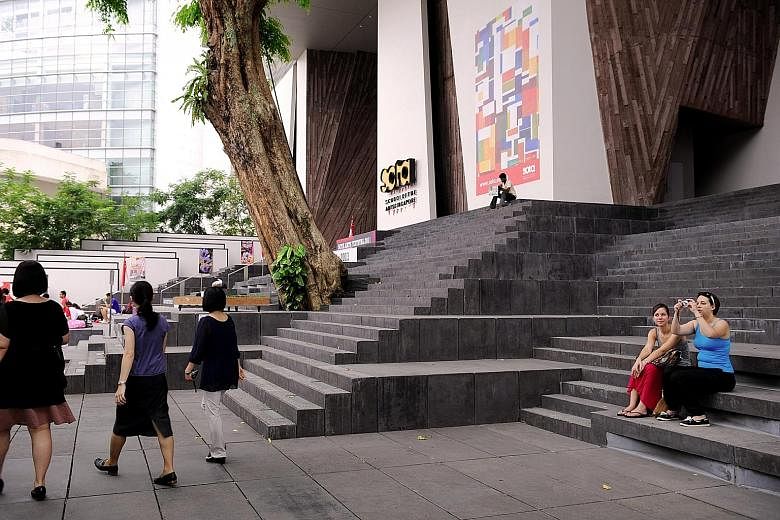Controversy erupted recently over the School of the Arts - Sota - (disclosure: my daughter is a student there) after news that fewer than three in 10 graduating students go on to pursue arts-related university courses.
Some people thought this meant the school had failed to nurture future artists; others asked if taxpayers' money was well-used to fund a school where so many did not go on to pursue arts courses.
The debate about Sota's raison d'etre and management has been useful and healthy. My personal conviction is that with or without Sota, Singapore, or any other society, needs the arts. One important reason is that the arts are the necessary lubricant for communication within and with other societies.
The arts are not only for the elite and to be enjoyed on special occasions. It is all around us and very much a daily practical occurrence. An example of this is The Straits Times itself - very much a daily work of art with text, photographs, graphics, advertisements, in a well-designed mix. If the ST were restricted only to the written word, communication would be dismal. That is why I sometimes think of my household hard copy of the ST as the "daily cave painting".
Apropos cave paintings, these started to emerge about 50,000 years ago around the world. We call it art today but the creators probably saw it as a practical way to express what speech could not.
Anthropologists now believe that the creators were trying to depict what they saw whilst in a trance. The creators were probably the hunter-warriors, who were often the leaders of the clans. Even then, the leaders were creative-communicative beings, in addition to being strong and athletic.
The written word and pictures are often inadequate to describe complex issues such as the Vietnam War's socio-economic impact on the United States - something that is of interest to me. What is etched in my mind are not the many words I have read on the issue, but the movie The Deer Hunter, about the war's impact on three American steelworkers. It has been selected for preservation in the US by the Library of Congress as being "culturally, historically, or aesthetically significant" in 1996. The film raked in many awards and was very profitable too.
Other messages sometimes require music as the artistic medium.

The musical score of Vivaldi's Four Seasons is an absolutely dead piece of paper but it is perhaps the best acoustic expression of nature's beauty when performed by the violin and other string instruments.
The arts also enable religions to articulate their messages. A fine modern example is St Mary's Cathedral in Tokyo by Kenzo Tange. This architectural masterpiece, seen from above, is shaped like a crucifix with a sunken centre. Alternatively, one could interpret it as a pair of hands, shaped like a crucifix, clasped together upwards in prayer. One could almost hear the building say: "Let us pray." Unwittingly, perhaps, the cathedral has benefited Tokyo financially, because it is now a tourist attraction that is highly ranked on Tripadvisor.com.
While Tokyo appeals to those seeking the eclectic nature of contemporary art, traditional art lovers can turn to Florence, Italy. After more than 500 years, Florence is still milking hundreds of millions annually from the millions of tourists who are there every year to gawk at its treasures in art and architecture.
Another important reason for societies to promote the arts is its positive influence on the mental development of young people. Change the mental ability of a child and you change his or her destiny. The positive impact of training in the arts is no longer a hypothetical assertion. Scientists have observed physical changes to the brain which correlate to higher mental abilities.
For example, training on the piano and violin fosters development of brain areas that are also used for mathematical and scientific reasoning. It is thus not a coincidence that two of the greatest physicists, Max Planck and Albert Einstein, were both trained and talented musicians.
Planck, the father of Quantum Theory, was so good with the piano that he had a choice of studying either physics or music at the university. Some friends and family members thought he made a mistake choosing physics. Without Quantum Theory, all the modern IT marvels we take for granted today would not exist.
Einstein, the father of Relativity and the greatest scientist ever, was a ladies' man in his youth, charming with his violin. Einstein himself credited his violin with being a big help in developing Relativity. Whenever he hit a mental roadblock in his work, he would go to his kitchen and play the violin for a while. Invariably, things appeared much clearer thereafter.
Examples of highly creative industrialists are Sir James Dyson (bladeless fans and vacuum cleaners) and Mr Sim Wong Woo. Dyson was a trained artist before turning his creativity to engineering designs. Mr Sim was a talented harmonica player and his passion for music played a key role in the invention of the Sound Blaster.
As for me, I am tone-deaf. Fortunately, I had an interest in chess and played it competitively until 18, representing my schools in the late 1970s. Today, chess is acknowledged as a whole-brain and creativity developer in children.
Unlike a computer, which primarily uses brute-force calculations to make decisions, human players use a mix of pattern recognition, imagination and calculations to make decisions. Even calculations by humans involve creative shortcuts. Chess is a good alternative to develop creative thinking for the tone-deaf.
The Singapore Government has correctly made creativity and innovation the centrepiece of future economic strategy. However, Singapore is not alone. This is so vital that the US state of Massachusetts (home state of the Massachusetts Institute of Technology and Harvard University) recently passed a landmark law mandating the teaching of creativity in the state's public schools.
Among other things, the law will evaluate schools on the opportunities they give students for developing creativity and innovation through the arts or any appropriate subject. Training in the arts is recognised by the scientific community as one of the best ways to develop creative thinking skills in children.
Perhaps the relevant question is not whether we need a Sota in Singapore, but whether we should have a mini Sota in every Singapore school.
Creativity should also be a key criterion when the Government hands out scholarships. If the goal is to be a creativity and innovation driven society, then we need leaders who can lead by example. Those who can confidently say: "Follow me."
• Joseph Chong was previously a portfolio manager and CEO of a wealth management firm. He holds a master's in naval architecture from a German university and was head of a defence research laboratory in the mid-1990s. He is semi-retired.

